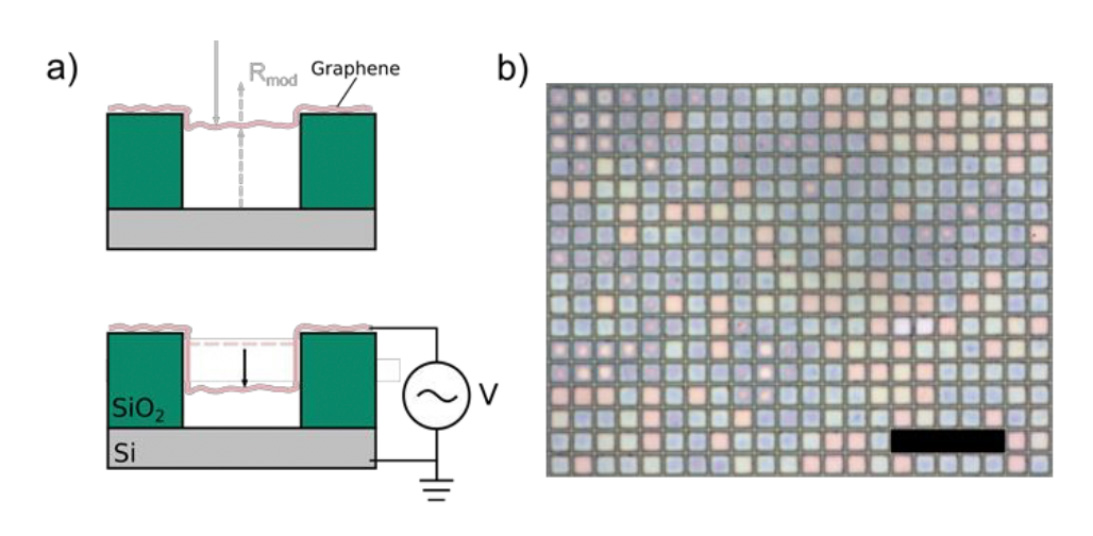GMOD®, a disruptive green tech for next-gen colourful displays.
THE TECHNOLOGY
Displays are the component in electronics that consume more power. Portable devices like gadgets for virtual /augmented reality (VR/AR) intensively drag electricity from batteries to convert it into light so images and videos are created, but such consumption limits the service life and user experience.
Alternatively, reflective-type displays (like those in e-book readers) consume little power although cannot provide colorful images nor fast frame rates to reproduce videos. VR/AR displays have requirements that standard technologies (microLED, OLED, LCD) cannot meet: higher resolution displays with smaller pixels that can change their color faster and with less power. MEGAMORPH project has the solution.
GMOD® technology
- GMOD® is a disruptive green tech for next-gen colourful displays: it combines the large dynamic range and power saving of liquid-based displays (LCD, electrowetting, electrophoretic) with the speed and gamut of solid-state displays (OLED, microLED).
- A Graphene MOdulator Display (GMOD®) is a reflective-type display (e-paper technology) whose pixels are micro- electromechanical systems (MEMS): electrically- controlled graphene micro-membranes that tune the white light to show natural colors by their mechanical movement.
- The electrically-controlled pixels are semitransparent membranes that modulate the ambient light without using power to generate light while having great contrast in bright environments, thus cutting down the average power consumption in display devices. GMOD® pixels are also ultra-small, enabling the ultimate resolution in VR displays for a truly-real virtual experience.
- Moreover, each GMOD® pixel is full-spectrum and diffraction-limited in size, hence eliminating the need of subpixels, which enables the ultimate resolution (>25000 pixels per inch -ppi-), a 1/3 reduction of data bandwidth and an incredibly low power consumption, all demanded by AR/VR and HUD markets.
- Last but not least, GMOD® does not require the use of expensive and toxic rare-earth materials; on the contrary, GMOD® integrates graphene, a biocompatible and environmentally-friendly material produced from small quantities of natural gas (methane).

Figure 1: a) Cross-section sketch of a GMOD® display pixel at rest (top) and when a voltage difference is applied between the CVD graphene and the silicon substrate (bottom).
Figure 2: b) Optical image of full-spectrum squared GMOD® pixels in a 3630 PPI prototype fabricated within ATTRACT Phase 1 GIMOD Project. Scale bar (black) is 35 μm.
Graphene powered
Graphene is the thinnest and strongest material known, which makes it suitable for mechanical micro-devices. As graphene is also a great electrical conductor, it can be moved with small voltages. Graphene is semitransparent, allowing part of the light to go through. These properties make graphene the best material for mechanical pixels as successfully demonstrated with prototypes in the Mobile World Congress 2017.
GMOD® vs IMOD
GMOD® is a breakthrough and over-performing substitute of IMOD, the predecessor technology developed by Qualcomm MEMS under the Mirasol trademark and bought by Apple in 2015. Mirasol displays are present in products such as the smartwatch Qualcomm Toq. Mirasol pixels are made of silicon materials and metal surfaces, making them thick and heavy. In contrast, GMOD® pixels are so thin and weightless that enable high frame rates with low power consumption. The thickness also determines how small a pixel can be: GMOD® technology can go beyond 12K resolution! These attributes are exactly the missing requirements that portable VR visors lack of in the present. Moreover, GMOD® acts as a technology platform for other photonic components that have applications in Industry 4.0 and New Space.
Read more
- GIMOD Project from H2020’s ATTRACT Consortium
- Graphene mechanical pixels for Interferometric MOdulator Displays, Nature Communications 9 (2018)
- Very large scale characterization of graphene mechanical devices using a colorimetry technique, Nanoscale 9 (2017)
- Colorimetry technique for scalable characterization of suspended graphene, Nano Letters 16 (2016)


